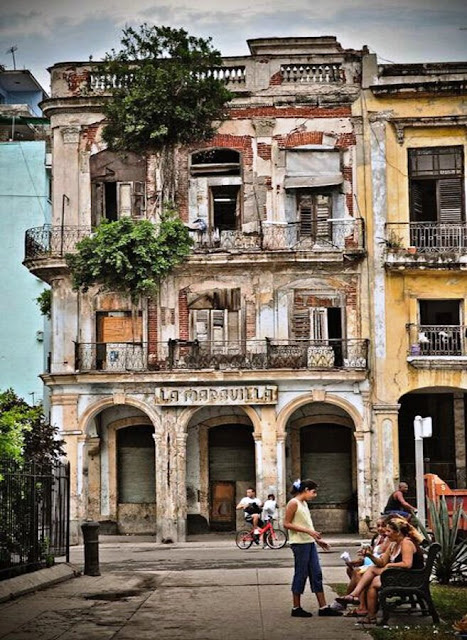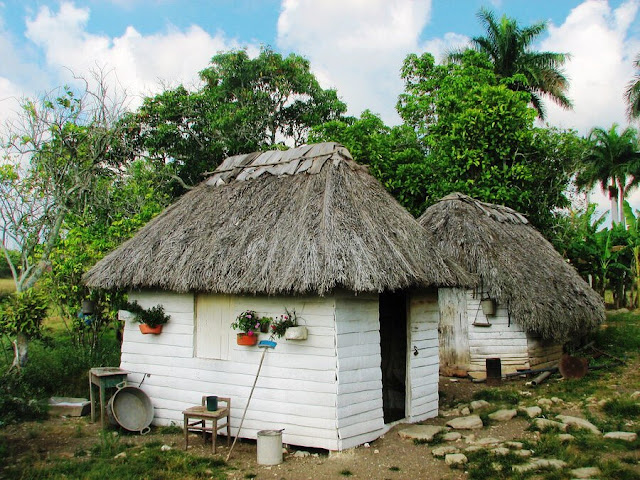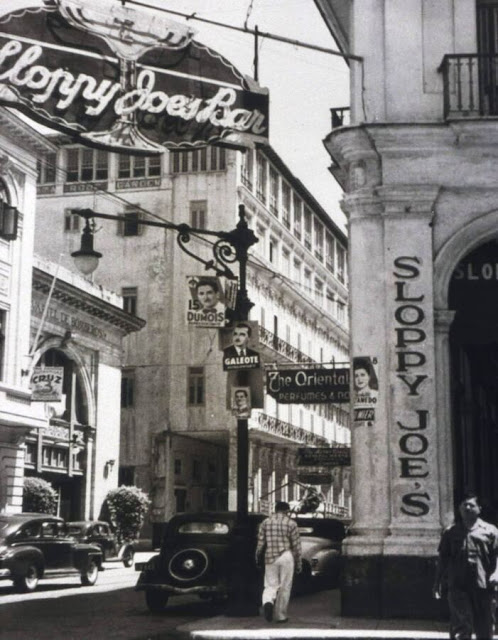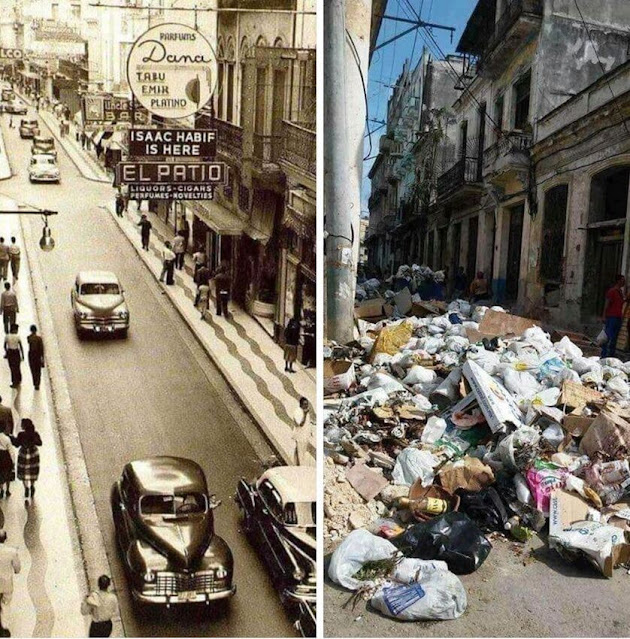
LA HABANA Y CUBA, DESCONECTADAS DEL MUNDO REAL. SIN GUIA PARA SALIR DEL ATOLLADERO. PHOTOS.
Mucho se han mencionado, comparándolo con las Siete Maravillas de la Antigüedad, las Siete Obras Maestras de la Ingeniería Civil Cubana como una muestra del desarrollo cubano, pero curiosamente todas fueron concebidas y financiadas antes del triunfo de la revolución. Y sorprendentemente, algunas se ejecutaron simultáneamente.
Estas obras fueron:
1- El Acueducto de Albear
2- El Túnel Sifón del Alcantarillado de La Habana
3- La Carretera Central de Cuba
4- El Túnel de la bahía de La Habana
5- El Edificio FOCSA
6- El Puente de Bacunayagua
7- El Viaducto La Farola
A esta última la revolución se quiere atribuir su obra, pero ya había sido diseñada, financiada y comenzada a ejecutar al triunfar el gobierno revolucionario.
Mientras tanto numerosas construcciones ejecutadas en esos años, demandaban financiamiento, mano de obras y muchos recursos. Era igual que la zafra, que nadie se enteraba cuando comenzaba y cuando concluía y se producían cifras récord de azúcar de acuerdo con la demanda del mercado.
Al llegar la etapa revolucionaria, con todos los elementos en sus manos, les tomó tres décadas concluir un mísero edificio de microbrigadas y ahora hasta para construir o remodelar hoteles tiene que importar obreros indios porque los trabajadores cubanos son improductivos porque no tienen estímulo y además se roban todo lo que puedan.
Por supuesto que por estas mismas razones, las grandes obras acometidas por la revolución, por lo regular ninguna se han concluido, como el triste caso de la Autopista Nacional, y las que lo han hecho, no han sido mantenidas debidamente y están en ruinas.
No quiero siquiera imaginar ninguna de las Siete Obras Maestras ejecutadas por una empresa socialista. Mejor ni pensar en eso porque nunca se hubieran ejecutado o terminado y su explicación es muy simple, aparte de la ineficiencia del sistema: la mano de Fidel Castro metidas en ellas.
LO QUE LA HABANA FUE
Voy a tener que creerme que es cierto lo que se dice de que Fidel Castro odiaba a La Habana y todo lo que ella representaba de desarrollo y de influencia del mundo capitalista, en particular de Estados Unidos y ese sentimiento se reforzó cuando fue rechazado en la Universidad de La Habana por sumarse a un grupo de “bonchistas” (léase criminales o gángsters), casi todos hijos de ricos como él, que no iban allí a estudiar, sino a hacer lo que se les viniera en ganas como buenos hijos de papá..
A Fidel Castro jamás le interesó la arquitectura ni la construcción, de ahí su rechazo y envidia contra José Antonio Echeverría, porque el estudiante de arquitectura tenía un nivel de liderazgo y era el presidente de la FEU, un cargo que él no pudo alcanzar en su paso por la escalinata, porque estaba catalogado como un pandillero y no como alguien a quien respetar. Decía Martí: “Los hombres se dividen en dos bandos: los que aman y fundan, los que odian y deshacen”. Fidel Castro fue de los segundos.
Por eso cuando se hizo del poder, metió a los arquitectos en el mismo saco de los artistas e intelectuales, los consideró problemáticos y definió que la cultura tenía que estar solamente a favor de la revolución, sin excepción alguna.
De ahí que la arquitectura, la construcción y el diseño no tuvieron mucho espacio en la Cuba de Castro, porque éste consideraba la estética como una parte de la mentalidad burguesa.
LA CUBA DE HOY
Siete millones y medio de cubanos, casi un ochenta por ciento de la población, no tienen vivienda o nunca la han tenido, hay un déficit de casi novecientas mil viviendas y más de la mitad de las existentes están en mal estado. No voy a hablar de lo otro, casi todas las generaciones posteriores al triunfo de la revolución no han sabido lo que es tener una vivienda propia y han coexistido en las existentes con los abuelos, los padres, los hijos, los nietos y hasta los bisnietos. Y lo peor, no se vislumbra posibilidad alguna de que esto cambie.
Hoy existen en la capital miles de edificaciones en ruinas, apuntalados, agrietadas y a punto de derrumbarse. Hay escombros por dondequiera, en algunos casos nos permite compararlas con zonas de las ciudades bombardeadas y testigos de la cruenta Segunda Guerra Mundial, como fueron Stalingrado, Londres, Dresde, Hamburgo o Tokio. A ello se le suman basureros por doquier, aguas albañales desbordadas y vectores en abundancia nunca antes vista y es preciso estar alerta porque si uno se descuida te puede caer encima las inmundicias lanzadas desde un piso alto.
Solamente en La Habana se derrumban como promedio tres viviendas diariamente, más de mil al año con el saldo de muertos y heridos. Una lluvia fuerte o un ciclón, inevitablemente va seguida de numerosos derrumbes.
La Habana del Siglo XXI se puede definir como una ciudad que se desmorona a la par de sus habitantes, inmersos en una sociedad en blanco y negro, descolorida y desconectada del mundo real, con un sistema político devastador, sin guía para salir del atolladero.
No se oye hablar de planes urbanísticos ni desarrollo habitacional, solamente de la construcción de lujosísimos hoteles destinados a engrosar las arcas de los que controlan al país. A los gobernantes cubanos no les interesa luchar por el bienestar del pueblo y ello incluye la decrepitud de la capital. Su legado va a ser un pequeño grupo de la cúpula de poder que se han vuelto millonarios y un país sumido en la miseria total, material y espiritual.
Como me comentó una vez un amigo ingeniero civil, cuando se acabe todo este desastre que nos ha dejado la revolución, lo más conveniente será pasar un ejército de bulldozers, comenzando en la península de Guanahacabibes y terminando en la Punta De Maisí, echándolo todo al mar y después reconstruirlo todo de nuevo, hay que erigir una nueva Cuba.
Da ganas de llorar cuando uno compara a Hiroshima y Nagasaki tras haber sido víctimas de las bombas nucleares y treinta años después verlas en su plenitud, y hacer similar comparación con La Habana de 1958 y la actual.

HAVANA AND CUBA, ARE DISCONNECTED FROM THE REAL WORLD. WITHOUT A GUIDE TO GET OUT OF THE MESS. PHOTOS.
Much has been said, comparing it with the Seven Wonders of Antiquity, the Seven Masterpieces of Cuban Civil Engineering as a sample of Cuban development, but curiously all were conceived and financed before the triumph of the revolution. And surprisingly, some were executed simultaneously.
These works were:
1- The Albear Aqueduct
2- The Havana Sewer Siphon Tunnel
3- The Central Highway of Cuba
4- The Havana Bay Tunnel
5- The FOCSA Building
6- The Bacunayagua Bridge
7- The La Farola Viaduct
The revolution wants to attribute its work to the latter, but it had already been designed, financed and started to be executed when the revolutionary government triumphed.
Meanwhile, numerous constructions carried out in those years required financing, labor and many resources. It was like the sugar harvest, no one knew when it began and when it ended and record figures of sugar were produced according to market demand.

When the revolutionary stage arrived, with all the elements in their hands, it took them three decades to finish a miserable micro-brigade building and now even to build or remodel hotels they have to import Indian workers because Cuban workers are unproductive because they have no incentive and they also steal everything they can.
Of course, for these same reasons, the great works undertaken by the revolution, as a rule, have not been completed, as in the sad case of the National Highway, and those that have been, have not been properly maintained and are in ruins.
I do not even want to imagine any of the Seven Masterpieces executed by a socialist company. It is better not to even think about it because they would never have been executed or finished and their explanation is very simple, apart from the inefficiency of the system: the hand of Fidel Castro involved in them.
WHAT HAVANA WAS
I’m going to have to believe that it’s true what they say, that Fidel Castro hated Havana and everything it represented in terms of development and the influence of the capitalist world, particularly the United States, and that feeling was reinforced when he was rejected from the University of Havana for joining a group of “bonchistas” (read criminals or gangsters), almost all of them sons of rich people like him, who didn’t go there to study, but to do whatever they wanted like good daddy’s boys.
Fidel Castro was never interested in architecture or construction, hence his rejection and envy of José Antonio Echeverría, because the architecture student had a level of leadership and was the president of the FEU, a position that he could not reach in his time on the steps, because he was classified as a gangster and not as someone to be respected. Martí said: “Men are divided into two groups: those who love and create, and those who hate and destroy.” Fidel Castro was one of the latter.
That is why when he took power, he put architects in the same bag as artists and intellectuals, considered them problematic and defined that culture had to be only in favor of the revolution, without any exception.
That is why architecture, construction and design did not have much space in Castro’s Cuba, because he considered aesthetics to be part of the bourgeois mentality.

CUBA TODAY
Seven and a half million Cubans, almost eighty percent of the population, do not have housing or have never had it, there is a deficit of almost nine hundred thousand homes and more than half of the existing ones are in poor condition. I’m not going to talk about the other thing, almost all the generations after the triumph of the revolution have not known what it is to have their own home and have coexisted in the existing ones with grandparents, parents, children, grandchildren and even great-grandchildren. And the worst thing is that there is no possibility of this changing.
Today there are thousands of buildings in the capital in ruins, propped up, cracked and about to collapse. There is rubble everywhere, in some cases it allows us to compare them with areas of the bombed cities and witnesses of the bloody Second World War, such as Stalingrad, London, Dresden, Hamburg or Tokyo. Added to this are garbage dumps everywhere, overflowing sewage and vectors in abundance never seen before and it is necessary to be alert because if one is careless, the filth thrown from a high floor can fall on top of you.
On average, three houses collapse every day in Havana alone, more than a thousand a year with the death and injury toll. A heavy rain or a cyclone is inevitably followed by numerous landslides.
Havana in the 21st century can be defined as a city that is crumbling along with its inhabitants, immersed in a black and white society, discoloured and disconnected from the real world, with a political system
Havana in the 21st century can be defined as a city that is crumbling along with its inhabitants, immersed in a black and white society, discoloured and disconnected from the real world, with a devastating political system, with no guide to get out of the quagmire.
There is no talk of urban planning or housing development, only of the construction of luxurious hotels destined to swell the coffers of those who control the country. The Cuban rulers are not interested in fighting for the well-being of the people and this includes the decrepitude of the capital. Their legacy will be a small group of the elite of power who have become millionaires and a country plunged into total misery, material and spiritual.
As a civil engineer friend once told me, when all this disaster left by the revolution is over, the best thing to do will be to bring in an army of bulldozers, starting on the Guanahacabibes peninsula and ending at Punta De Maisí, throwing everything into the sea and then rebuilding everything again. We must build a new Cuba.
It makes you want to cry when you compare Hiroshima and Nagasaki after having been victims of nuclear bombs and thirty years later seeing them in their fullness, and make a similar comparison with Havana in 1958 and today.

Agencies/ NostalgiaCubana/ Carlos Rodríguez Buá/ Extractos/ Excerpts/ Internet Photos/ Arnoldo Varona/ www.TheCubanHistory.com
LA HISTORIA DE CUBA
THE CUBAN HISTORY, HOLLYWOOD.




 LA HABANA Y CUBA, desconectadas del Mundo Real. Sin Guia para Salir del Atolladero. PHOTOS. * HAVANA AND CUBA, disconnected from the Real World. Without a Guide to Get Out of the Mess. PHOTOS.
LA HABANA Y CUBA, desconectadas del Mundo Real. Sin Guia para Salir del Atolladero. PHOTOS. * HAVANA AND CUBA, disconnected from the Real World. Without a Guide to Get Out of the Mess. PHOTOS.